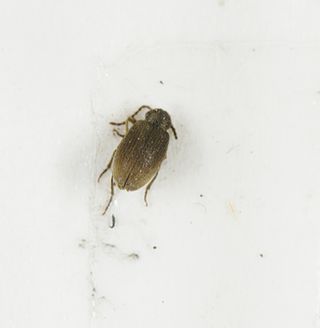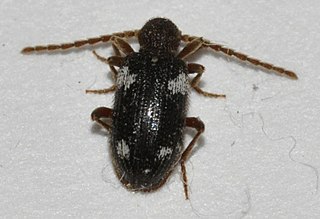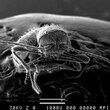
The longhorn beetles (Cerambycidae), also known as long-horned or longicorns, are a large family of beetles, with over 35,000 species described.

Bostrichoidea is a superfamily of beetles. It is the type superfamily of the infraorder Bostrichiformia.

Spider beetles make up the subfamily Ptininae, in the family Ptinidae. There are approximately 70 genera and 600 species in the subfamily, with about 12 genera and 70 species in North America north of Mexico.

Ptinidae is a family of beetles in the superfamily Bostrichoidea. There are at least 220 genera and 2,200 described species in Ptinidae worldwide. The family includes spider beetles and deathwatch beetles.

Xyletininae is a subfamily of death-watch and spider beetles in the family Ptinidae. There are about 13 genera and at least 170 described species in Xyletininae.

Anobiinae is the subfamily of death-watch beetles in the family Ptinidae, with at least 45 genera. It was formerly considered a member of the family Anobiidae, but its family name has since been changed to Ptinidae.

Dorcatominae is a subfamily of death-watch and spider beetles in the family Ptinidae. There are about 16 genera and at least 190 described species in Dorcatominae.

Dryophilinae is a subfamily of death-watch and spider beetles in the family Ptinidae. There are at least six genera and two described species in Dryophilinae.

Ernobiinae is a subfamily of death-watch and spider beetles in the family Ptinidae. There are about 8 genera and at least 90 described species in Ernobiinae.

Lasioderma is a genus of beetles in the family Ptinidae. As of 1990, there were over 50 species in the genus.

Mesocoelopodinae is a subfamily of death-watch and spider beetles in the family Ptinidae. There are at least 4 genera and 100 described species in Mesocoelopodinae.

Tricorynus is a genus of deathwatch and spider beetles in the family Ptinidae. There are at least 90 described species in Tricorynus.
Calytheca is a genus of beetles in the family Ptinidae. There are at least two described species in Calytheca, C. elongata White 1973 and C. convexa White.
Cryptoramorphus is a genus of death-watch and spider beetles in the family Ptinidae. There are at least two described species in Cryptoramorphus, C. floridanus and C. flavidus.
Stagetus is a genus of death-watch and spider beetles in the family Ptinidae. There are at least 20 described species in Stagetus. They eat fungi.

Ptinus tectus, often called the Australian spider beetle, is a species of beetle in the family Ptinidae, or family Anobiidae, subfamily Ptininae. It is a cosmopolitan species. It is a pest of stored foods and museum specimens.

Ptinus is a genus of beetles distributed throughout much of the world, including Africa, the Australian region, the Palearctic, the Near East, the Nearctic, and the Neotropical realm. It is a member of the subfamily Ptininae, the spider beetles.

Xyletinini is a tribe of death-watch and spider beetles in the family Ptinidae. There are at least 10 genera and 70 described species in Xyletinini.
Lasiodermini is a tribe of death-watch and spider beetles in the family Ptinidae. There are at least 3 genera and 30 described species in Lasiodermini.

Ptinini is a tribe of spider beetles in the family Ptinidae. There are about 18 genera and at least 120 described species in Ptinini.




















